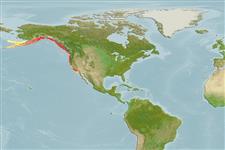>
Perciformes/Scorpaenoidei (Scorpionfishes) >
Sebastidae (Rockfishes, rockcods and thornyheads) > Sebastinae
Etymology: Sebastes: Greek, sebastes = august, venerable (Ref. 45335); paucispinis: From the Latin pauci and spinus, connoting 'few' and 'spine' (Ref. 27436).
More on author: Ayres.
Environment: milieu / climate zone / depth range / distribution range
Ecologie
marien rifbewoner; diepte 0 - 476 m (Ref. 27437). Subtropical; 65°N - 31°N
Eastern Pacific: Stepovak Bay, Alaskan Peninsula to Punta Blanca, Baja California, Mexico.
Lengte bij maturiteit / Grootte / Gewicht / Leeftijd
Maturity: Lm 48.0, range 36 - ? cm
Max length : 91.0 cm TL mannelijk / geslacht onbekend; (Ref. 2850); max. gepubliceerd gewicht: 9.6 kg (Ref. 4690); max. gerapporteerde leeftijd: 50 Jaren (Ref. 75794)
Korte beschrijving
Determinatiesleutels | Morfologie | Morfometrie
Dorsale stekels (totaal) : 13 - 15; Dorsale zachte stralen (totaal) : 13 - 16; Anale stekels: 3; Anale zachte stralen: 8 - 10; Wervels: 26. A large rockfish with weak head spines - nasal and parietal spines usually absent, preocular, supraocular, postocular, tympanic, coronal and nuchal spines absent (Ref. 27437). Lower jaw long, thickened, with no real symphyseal knob and projects past upper jaw; maxillary extends to behind the eye; parietal ridges parallel (Ref. 27437). Caudal slightly indented (Ref. 6885). Olive orange to burnt orange or brown in color (Ref. 27437). Branchiostegal rays: 7 (Ref. 36715).
Adults found over rocky reefs, but also common on open bottoms to about 320 m (Ref. 2850). Juveniles are pelagic and settle in near shore nursery areas, then move to deeper habitats (Ref. 36715). Young form schools (Ref. 2850). Feed mainly on fishes, including other rockfishes (Ref. 2850). Ovoviviparous, with planktonic larvae (Ref. 36715, 6885, 34817). Validated age by radiometry is 37 yrs (Ref. 75794). A famous sport fish throughout its range (Ref. 2850). Flesh is of excellent quality when kept chilled (Ref. 27436). Sold with other rockfish species (Ref. 27436).
Eschmeyer, W.N., E.S. Herald and H. Hammann, 1983. A field guide to Pacific coast fishes of North America. Boston (MA, USA): Houghton Mifflin Company. xii+336 p. (Ref. 2850)
Status op de Rode Lijst van het IUCN (Ref. 130435: Version 2024-1)
Gebruik door de mens
Visserij: van minder commercieel belang; sportvis: ja; Aquarium: Publieke aquaria
Tools
Speciale rapporten
Download XML
Internetbronnen
Estimates based on models
Preferred temperature (Ref.
123201): 4.5 - 8.9, mean 5.9 °C (based on 177 cells).
Fylogenetische diversiteitsindex (Ref.
82804): PD
50 = 0.5000 [Uniqueness, from 0.5 = low to 2.0 = high].
Bayesian length-weight: a=0.01000 (0.00495 - 0.02022), b=3.09 (2.92 - 3.26), in cm total length, based on LWR estimates for this Genus-body shape (Ref.
93245).
Trofisch niveau (Ref.
69278): 3.5 ±0.46 se; based on food items.
Weerstandsvermogen (Ref.
120179): laag, minimale populatieverdubbelingstijd 4,5-14 jaar (tm=4; tmax=50; Musick et al. 2000 (Ref.
36717)).
Prior r = 0.25, 95% CL = 0.17 - 0.38, Based on 2 full stock assessments.
Fishing Vulnerability (Ref.
59153): High vulnerability (63 of 100).
Climate Vulnerability (Ref.
125649): Moderate to high vulnerability (45 of 100).
Nutrients (Ref.
124155): Calcium = 11 [4, 34] mg/100g; Iron = 0.34 [0.13, 0.81] mg/100g; Protein = 19.2 [18.0, 20.4] %; Omega3 = 0.4 [0.2, 1.0] g/100g; Selenium = 66.5 [22.9, 204.1] μg/100g; VitaminA = 52.6 [18.2, 150.1] μg/100g; Zinc = 0.446 [0.224, 0.863] mg/100g (wet weight);
